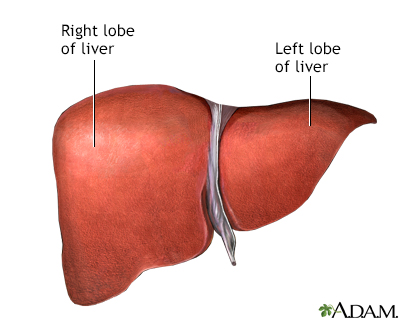Pregnancy SmartSiteTM
Liver disease due to alcohol; Cirrhosis or hepatitis - alcoholic; Laennec's cirrhosis DefinitionAlcoholic liver disease is damage to the liver and its function due to alcohol abuse. CausesAlcoholic liver disease most often occurs after years of heavy drinking. Over time, scarring and cirrhosis can occur. Cirrhosis is the final phase of alcoholic liver disease. Alcoholic liver disease does not occur in all heavy drinkers. The chances of getting liver disease go up the longer you have been drinking and more alcohol you consume. You do not have to get drunk for the disease to happen. The disease is most common in people between 40 and 50 years of age. Men are more likely to have this problem. However, women may develop the disease after less exposure to alcohol than men. Some people may have an inherited risk for the disease. SymptomsThere may be no symptoms, or symptoms may come on slowly. This depends on how well the liver is working. Symptoms tend to be worse after a period of heavy drinking. Early symptoms include:
As liver function worsens, symptoms may include:
Exams and TestsYour health care provider will do a physical exam to look for:
Tests you may have include:
Tests to rule out other diseases include:
TreatmentLIFESTYLE CHANGES Some things you can do to help take care of your liver disease are:
MEDICINES FROM YOUR DOCTOR
OTHER TREATMENTS
When cirrhosis progresses to end-stage liver disease, a liver transplant may be needed. Liver transplantation for alcoholic liver disease is only considered in people who have completely avoided alcohol for 6 months. Support GroupsMore information and support for people with alcoholic liver disease and their families can be found by joining support groups for alcoholism or liver disease. Outlook (Prognosis)Alcoholic liver disease is treatable if it is caught before it causes severe damage. However, continued excessive drinking can shorten your lifespan. Cirrhosis further worsens the condition and can lead to serious complications. In case of severe damage, the liver cannot heal or return to normal function. Possible ComplicationsComplications may include:
When to Contact a Medical ProfessionalContact your provider if you:
Get emergency medical help right away if you have:
PreventionTalk openly to your provider about your alcohol intake. The provider can counsel you about how much alcohol is safe for you. ReferencesChalasani NP, Maher J. Alcoholic and nonalcoholic steatohepatitis. In: Goldman L, Cooney KA, eds. Goldman-Cecil Medicine. 27th ed. Philadelphia, PA: Elsevier; 2024:chap 138. Haines EJ, Thompson H. Liver and biliary tract disorders. In: Walls RM, ed. Rosen's Emergency Medicine: Concepts and Clinical Practice. 10th ed. Philadelphia, PA: Elsevier; 2023:chap 76. Szabo G, McClain CJ. Alcohol-associated liver disease. In: Feldman M, Friedman LS, Brandt LJ, eds. Sleisenger and Fordtran's Gastrointestinal and Liver Disease. 11th ed. Philadelphia, PA: Elsevier; 2021:chap 86. | |
| |
Review Date: 8/7/2023 Reviewed By: Michael M. Phillips, MD, Emeritus Professor of Medicine, The George Washington University School of Medicine, Washington, DC. Also reviewed by David C. Dugdale, MD, Medical Director, Brenda Conaway, Editorial Director, and the A.D.A.M. Editorial team. The information provided herein should not be used during any medical emergency or for the diagnosis or treatment of any medical condition. A licensed medical professional should be consulted for diagnosis and treatment of any and all medical conditions. Links to other sites are provided for information only -- they do not constitute endorsements of those other sites. No warranty of any kind, either expressed or implied, is made as to the accuracy, reliability, timeliness, or correctness of any translations made by a third-party service of the information provided herein into any other language. © 1997- A.D.A.M., a business unit of Ebix, Inc. Any duplication or distribution of the information contained herein is strictly prohibited. | |

 Digestive system
Digestive system Liver anatomy
Liver anatomy Fatty liver - CT s...
Fatty liver - CT s...
